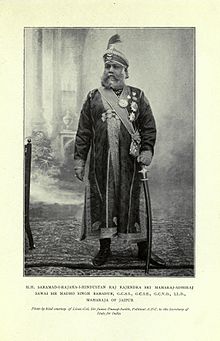HH Saramad-e-Raja-e-Hindustan Raj-Rajeshwar Raj-Rajendra Maharajadhiraj Shri Maharaja Sawai Sir Madho Singh II GCSI GCIE GCVO GBE (28 August 1862 – 7 September 1922), was the Maharaja of the Princely State of Jaipur from the year 1880 until 1922. He was the adopted son of the previous ruler Sawai Ram Singh II, Maharaja of Jaipur.[1]
| Madho Singh II | |
|---|---|
 | |
| Maharaja of Jaipur | |
| Reign | 10 August 1880 – 7 September 1922 |
| Predecessor | Ram Singh II |
| Successor | Man Singh II |
| Born | August 28, 1862 |
| Died | September 7, 1922 (aged 60) |
| Spouse | HH Maharaniji Sa Jadonji Shri Kushal Kanwarji Saheba of Amargarh, Etah in United Provinces of Agra and Oudh
HH Maharaniji Sa Rathorji Shri Saubhag Kanwarji Saheba of Kishangarh State HH Maharaniji Sa Jhaliji Shri Takht Kanwarji Saheba of Dhrangadhra State in Gujarat HH Maharaniji Sa Rathorji Shri Ajab Kanwarji Saheba of Khamnor in Shahpura State HH Maharaniji Sa Tanwarji Shri Udai Kanwarji Saheba of Reri in Bikaner State |
| Issue | two daughters (died infant) by Rathorji of Kishangarh |
| Father | Raj Thakuran Raghunath Singhji of Isarda in Jaipur State |
| Mother | Rathorji Anand Kanwarji (Chandrasenotji) d.of Rao Sardar Singhji of Kerote in Ajmer |
Biography
editHe was born Kunwar Kaim Singh Rajawat, the second son of the Thakur Raghunath Singhji of Isarda, a petty chieftain related to the ruling Kachwaha house of Jaipur . After the death of their father, a dispute with his elder brother over the succession left the teenaged Kaim exiled and living in poverty. He found work as a risaldar in the cavalry of the Nawab of Tonk.[1]
His fate was altered by his encounters with the guru Brahmachari Giridhari Sharan, whose disciple he became, and with the ruling Sawai Ram Singh II. When the childless Ram Singh died in 1880, Kaim Singh who was chosen on his deathbed to be adopted as his successor, was crowned under the name Madho Singh.[1] Married as his first wife later Patrani a Jadon lady related to the house of Karauli State Kushal Kanwarji daughter of Rao Budhpal Singhji of Amargarh estate, Etah in United Provinces of Agra and Oudh.
As the ruler of the large and prosperous state of Jaipur,Sawai Madho Singh embraced modern ideas on education and sanitation. He built schools, colleges, hospitals and a museum. When famine struck in 1896–1897 and 1899–1900, he used state funds to feed the population. He also appealed to the Viceroy, Lord Curzon, to start a permanent Famine Relief Fund, which Singh began with a gift of £133,000 (equivalent to £18,176,667 in 2023).[1]
Sawai Madho Singh II was exceptionally loyal to the British crown, and sent his troops and horses to assist the British side in fighting in Chitral in 1894–1895, the Tirah Campaign in 1897–1898 and in the South African War. In the First World War, he again sent his men and machine guns to assist in the Mesopotamian campaign at his own expense.[1]
Sawai Madho Singh II was made an honorary Major-General, and was further rewarded with honours. He was made Knight Grand Commander of the Order of the Star of India and of the Order of the Indian Empire, and a Knight Grand Cross of the Royal Victorian Order and of the Order of the British Empire.[2]
In the year 1921, he adopted the second son of the Thakur of Isarda (his great-grandnephew), whose wife was related to his Jadon queen. He died in 1922 and was succeeded by his adopted son, (Mor Mukut Singh) Maharaja Sawai Man Singh II.[1]
Honours
editHe was honored with GCSI in 1896, GCIE in 1901, and GCVO in 1903 AD.[3][4] He was given the honorary degree of LLD by the University of Edinburgh in 1908.[4] He also received the Hon rank of Major General in 1911 AD. In 1919, he was honored with GBE.[4] He also received:
- Member of the First Class of the Order of the Crown of Prussia: 1910[5]
- Donat of the Order of the Hospital of the St. John of Jerusalem: 1912[5]
Salute
editHe was entitled to a salute of 21 guns.[3]
References
edit- ^ a b c d e f "Death of Maharaja of Jaipur". The Times. 12 September 1922. p. 13.
- ^ "No. 30451". The London Gazette (Supplement). 1 January 1918. p. 84.
- ^ a b Purushotam Vishram Mawjee (1911). (1911) Imperial durbar album of the Indian princes, chiefs and zamindars, Vol. I.
- ^ a b c Singh, harnath (1959). Jaipur And Its Environs.
- ^ a b Leading Officials, A. (2017). Leading Officials, Nobles, And Personages In The Native States Of Rajasthan : Not Available : Free Download, Borrow, and Streaming : Internet Archive. [online] Internet Archive. Available at: https://archive.org/details/in.ernet.dli.2015.34620/page/n27 [Accessed 8 May 2019].